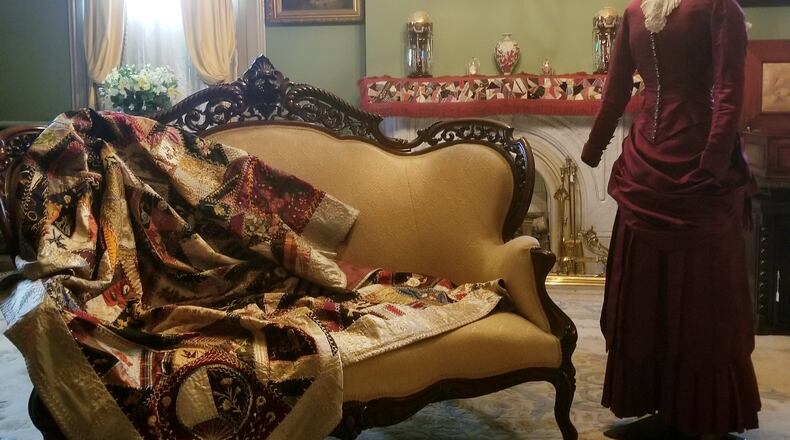It’s certainly a celebration of the women’s work back in that time period, she said.
“This is a legacy that the women have left behind. Most of our quilts, we don’t know who made them and it’s a shame, but it’s testament to the artistry and craftsmanship that these women had,” Creighton said.
Many women didn’t sign their work, because it was viewed to be “prideful,” but everyone owned quilts. Women would use their artistic abilities to make quilts pretty, and in addition to them being practical for warmth, quilts were also displayed in homes. Women would put a lot of work and effort into making the quilts.
“Quilted Treasures: Stories in the Stitches” will be on display through Mon., Sept. 12 during the historical society’s summer hours on Tuesdays through Fridays from 10 a.m. to 3 p.m. and on Saturdays from 10 a.m. to 2 p.m. (Closed Sundays and Mondays.) The exhibition is free and open to the public. Donations are accepted.
Quilts in the “Quilted Treasures: Stories in the Stitches” exhibition are from the Butler County Historical Society’s collection. The exhibit presents the role of quilt-making in 19th Century America, the cultural significance of quilts and their personal meaning to the women that made them. Throughout the exhibition, period fashions are paired with the quilts to show that textiles manufactured for clothing were also a source of quilt fabric. The exhibition was organized by Mary Royer, a volunteer and member of the American Quilt Study Group and Midwest Fabric Study Group.
“The Butler County Historical Society has a comprehensive collection of quilts. Some of the quilts are judged to be from around 1840, so that goes back quite a ways, close to 180 years, and it’s a very representative collection of different styles and trends through the years. So, it’s wonderful that we’re showcasing these quilts,” said Mary Royer.
BCHS has 55 to 60 quilts as part of its permanent collection. There are about 30 quilts in the exhibition, ranging in smaller, doll-sized and cradle-sized quilts to quite large, full, bed-sized quilts.
“Going back to the earlier quilts, some of the earliest were from the 1840s to the 1860s, everything was hand work. All women, of all social classes, learned needlework. It was almost part of their survival. The sewing machine was invented in 1848, and it took a while for it to become fully in use. Women sewed clothing at home for themselves and their families. You didn’t buy it in a shop, unless you were wealthy. Then, you could have a dressmaker make your clothing. So, all women had to learn to sew,” Royer said.
Quilting began to grow in the United States around the 1830′s, when fabric was being manufactured in the United States at lower prices. It became more affordable. So, people began to start quilting and they had excellent needlework skills, she said.
“So, that’s what we see in the 1840s to the 1860s and 1870s. Some quilts were finely made, but not all quilts were. Some had to be made quickly, so you could put it into use very quickly as a warm bed covering, but many quilts, and many in the collection, were made for what people call ‘best’ and they were not meant for daily use,” Royer said.
“Best” quilts were special quilts that were made for a marriage, and they were preserved, or for when quests came to your home. These quilts didn’t show signs of wear and tear, usage, or laundering. Many of the patterns in the quilts were original designs.
“It was a creative outlet in many ways. It was a way to express yourself, and it was one of the few forms for women, early on, that they could have a visible form of personal accomplishment,” Royer said.
The exhibition reflects a wide range of quilts — from what was put into the quilt, the reason for making the quilt, or how fast you had to make it. Some of the quilts on display are hanging on a wall, while others are draped on quilt racks, or shown on beds.
All the quilts have been donated by different families over the years, and most of them have a Butler County connection. There is also a representation of all the trends and fads when it comes to the patterns, such as the “log cabin quilt,” “hexagon quilt” and “fancy crazy quilt” or “plain crazy quilt” from the 1800′s to about 1920.
As part of a Multigenerational Summer Program at the historical society on 10 a.m. to 2 p.m. July 9, guests can experience “Quilted Treasures” by taking a sewing lesson, where they learn to sew by hand, find out about spinning wool, or gather clues in a scavenger hunt. Guests can show up and participate. Activities will be held outdoors on the front lawn. In case of rain, the program will be held inside the Emma Ritchie Auditorium.
HOW TO GO
What: “Quilted Treasures” exhibition
Where: The Benninghofen House Museum/ Butler County Historical Society , 327 N. Second St., Hamilton
Info: bchistoricalsociety.com, (513) 896-9930
About the Author
